selective attention
1/46
There's no tags or description
Looks like no tags are added yet.
Name | Mastery | Learn | Test | Matching | Spaced |
|---|
No study sessions yet.
47 Terms
areas
Brocas area (located in the frontal lobe, usually in the left hemisphere)
primarily responsible for speech production and articulation
helps in forming grammatically correct sentences
coordinates motor functions needed for speaking
Wernickes area (located in the superior temporal gyrus, in the left hemisphere)
primarily responsible for language comprehension
helps in understanding spoken and written language
plays a role in meaningful sentence formation

evidence for specialised structure-computing (parsing) module in our brains
Broca’s aphasia and comprehension difficulties
while Broca’s aphasia is typically associated with difficulty in speech production, some Broca’s aphasia patients also struggle with comprehension
their comprehension deficits mainly appear in syntactically complex sentences
Challenges with complex sentence structure:
Example: ‘put the small round green circle to the left of the brown square above the triangle’
This sentence requires hierarchical parsing and spatial reasoning, which Broca’s aphasia patients often find difficult
problems with reversible sentences
example
‘the dancer applauds the clown’
since both dancer and clown can be subjects or objects, word order and grammatical markers (like affixes or function words) are crucial to determine meaning
Broca’s aphasia patients often rely on semantic cues rather than syntax, so they may struggle to correctly interpret who is performing the action
what this tells us about Broca’s area
this supports the idea that Broca’s area is crucial not only for speech production but also for underlying syntax and sentence structure
Patients with Broca’s aphasia rely more on meaning (semantics) rather than syntax, leading to difficulties in interpreting sentences where meaning depends on grammatical structure rather than word meaning
perception and attention

perception: successful perception involves making educated guesses about the world
attention: we cannot attend to everything so we attend to some things and not others. We miss a surprising amount of what goes on in the world
dividing attention between voices: the ‘cocktail party’ problem
we cannot understand/remember the contents of two concurrent spoken messages (Cherry, 1950s)
the best we can do is alternate between attending selectively to the speakers
wheres the bottleneck?
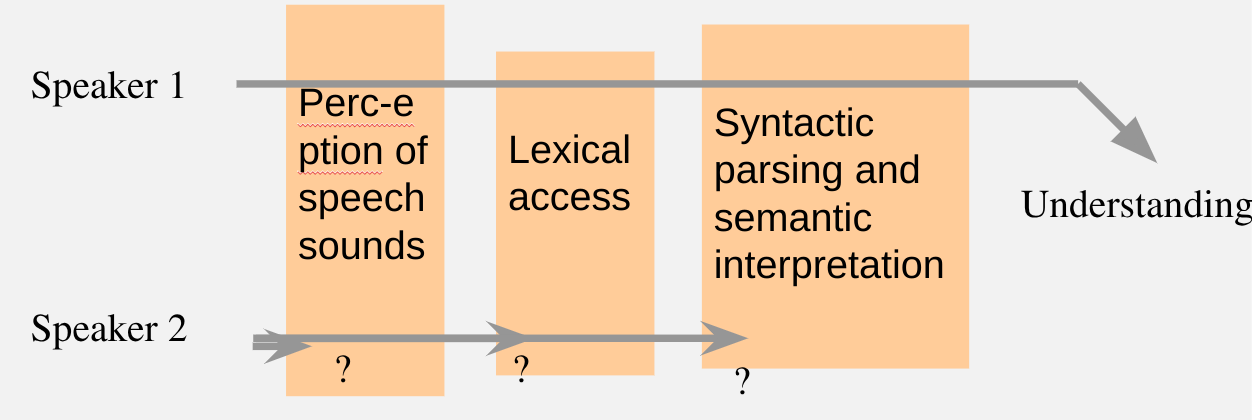
focused attention to one of two simultaneous speech messages
‘shadowing’ (ie repeating aloud) one of the messages is
successful if the messages differ in physical properties (location, voice, amplitude)
not successful if they differ only in semantic content (eg novel versus recipe, or two categories of word)
what kind of changes do participants notice in the unattended message?
physical changes (location, voice, volume, gross phonetics)
not semantic changes (ie from meaningful to meaningless, words to pseudowords)
word repeated 35 times in unattended message not remembered better (in later unexpected recognition test) than word heard once
Experiments in the 1960s by Treisman, Moray, and others
attentional selection precedes lexical identification and access to meaning?
it seems that unattended words are ‘filtered out’ early, after analysis of physical attributes, before access to identity/meaning
so, though aware of unattended speech as sounds with pitch, loudness and phonetic characteristics (in the background), we do not seem to process their identity or meaning
if required to extract identity or meaning from 2 sources, participant has to switch the attention filter between them - a slow and effortful process:
Broadbent’s (1958) dichotic split-span experiment:

Broadbent’s (1958) ‘Filter’ model

sensory features of all speech sources are processed in parallel and stored briefly in sensory memory (‘echoic memory’)
a selective ‘filter’ is directed only to once source at a time
filter is early in processing, so that only information that passes through the filter achieves
recognition (of words, objects, faces)
activation of their meaning
representation in memory (WM and LTM)
control of voluntary action
access to conscious awareness
2 additional assumptions of Broadbent’s account
filter is all-or-none
filter is obligatory ‘structural’ bottleneck
but (it turned out) filtering is not all-or-none
examples of partial ‘breakthrough’ of meaning of unattended speech in shadowing experiments:
own name often noticed in unattended speech
interpretation of lexically ambiguous words in attended message influenced by meaning of words in unattended message
attended: they saw the port for the first time
unattended: they drank until the bottle was empty
condition a galvanic skin response to eg Chicago. Then:
GSR evoked by ‘Chicago’ in unattended message, though participant does not notice/remember ‘Chicago’
effect generalises to related city names eg New York
ie meaning has been activated, not just sound pattern detected
but GSRs to unattended than to attended names: semantic activation by unattended input is attenuated, though not blocked
‘breakthrough’ demonstrations inspired: ‘late selection’ theories

theory: both attended and unattended words processed up to and including identification and meaning activation; relevant meanings then picked out on a basis of permanent salience or current relevance
but doesn’t explain why
selection on the basis of sensory attributes so much more efficient than selection on the basis of meaning
GSR to unattended probe words weaker than to attended
the resolution: filter-attenuation theory (Triesman, 1969)

there is an early filter but
it is not all-or-none: it attenuates (turns down) input from attenuated sources (hence, with the support of top-down activation, unattended words, if salient or contextually relevant, can still activate meanings)
early filtering is an optional strategy (not a fixed structural bottleneck)
early selection an option not a structural bottleneck
monitoring for target word (animal name)
left ear: plate cloth day fog tent risk bear..
right ear: hat king pig groan loaf cope lint
Task: press L or R key when animal name is heard
after practice, target detection as accurate when a word target must be detected on either ear as only one
unless selective understanding/repetition of one message is required eg.

part 2 - vision
There is quite a lot of evidence that when you display an array of objects very briefly, such as in Sperling’s experiments I described previously, we can select which ones to report on the basis of their physical properties, like colour, size, etc., but not their category – e.g. letter or digit.
However such displays are rather unrepresentative of normal vision, where we are dealing with dynamic visual events.
One difference between visual and auditory attention is that while we can’t really select a sound to attend to by pointing our ears at it, we clearly do this with vision. That is, usually when we want to attend to an object, we fixate that object so as to get its image on to the fovea, where we have high acuity and good colour discrimination.
But we can also move attention independently of fixation. For example, there are social situations where we don’t want to be seen to be looking at someone, but we can attend to what they are doing
An influential way of probing this voluntary movement of visual attention within the visual field was introduced by Mike Posner. Just try a few trials of his paradigm.
the attentional ‘spotlight’ (of covert attention)

‘endogenous cueing’
probable stimulus location indicated by arrow cue (80% valid) or not - neutral cue
participant responds as fast as possible to stimulus (maintaining central fixation)
simple RT to onset
choice ‘spatial’ RT (left/right from centre)
choice ‘symbolic’ RT (letter/digit)
all faster for expected location and slower for unexpected
The arrow cue enables you to shift your attention to the expected location without moving your eyes (and Posner monitored eye movements). There were also trials where an uninformative “neutral” cue was presented
What is the consequence of shifting one’s attentional “spotlight” to a location in this covert way? On average, responses were faster to a stimulus when it occurs in the expected -- and therefore attended – location, and slower to a target in the unattended location
So the processing of stimuli in the attentional spotlight enjoys an efficiency gain, and stimuli outside the spotlight an efficiency penalty.
In this case the orienting of attention was voluntary, driven by expectation
‘endogenous’ (voluntary, top-down) vs ‘exogenous’ (stimulus driven, bottom-up) shifts
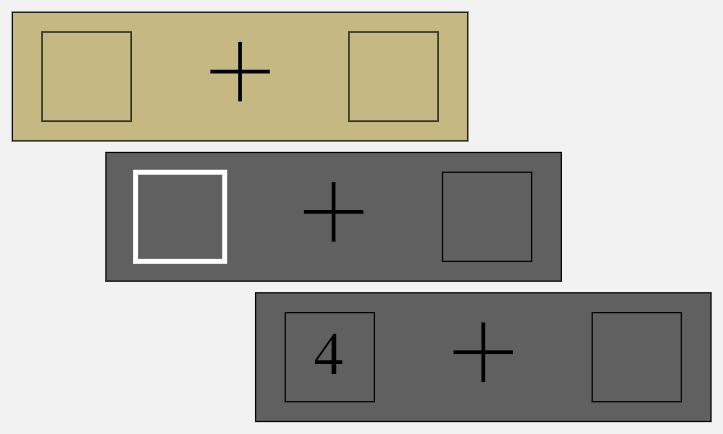
RT faster just after sudden onset/change at the stimulus location
although it does not predict the stimulus location
Timing of this ‘exogenous’ cueing is different from endogenous:
exogenous attraction of ‘the spotlight’ is fast
endogenous movement of ‘spotlight’ is slower
But the attentional spotlight also gets attracted involuntarily, or automatically, to an isolated and salient change somewhere in the visual field. This too was studied by Posner. Now, instead of an arrow being presented before the stimulus, one of the boxes suddenly flashed, and this was completely random with respect to which side the stimulus was on: i.e. it didn’t predict where the stimulus would be. Nevertheless he found an advantage for a stimulus presented in the box that has just flashed.
So a sudden onset or movement in the visual field -- a singleton - as attention researchers call it -- automatically captures attention.
This automatic stimulus driven -- exogenous --shift of attention happens very quickly (<200 ms)
The endogenous, or voluntary shift of attention is slower: it takes maybe half a second or more to shift.
Posner's paradigm has recently been used in combination with measures of brain activation to address the question of how early in the processing of visual information this selective focusing happens
recap
endogenous cueing (voluntary, top-down)
attention is guided internally based on expectations and prior knowledge
stimulus location is indicated by a cue (eg an arrow or number)
the cue is valid 80% of the time, encouraging voluntary allocation of attention
reaction time (RT) is measured:
faster for expected locations
slower for unexpected locations
exogenous cueing (stimulus driven, bottom-up)
attention is captured automatically by a sudden visual change (eg. flash or onset of a stimulus)
even if the change does not predict the target location, RT is still faster at the cued location due to automatic attraction of attention
timing differences:
exogenous shifts occur very fast (<200ms)
endogenous shifts take several hundred milliseconds
voluntary attention to a spatial locus modulates early components of the ERP in extra-striate visual cortex (mangun et al 1993)
the PI component of the event-related potential (ERP) is enhanced when attention is directed to a spatial location
the graph (bottom left) shows how attention to the left (red line) enhances the PI response compared to ignoring the left (blue dashed line)
the topographic brain maps (right side) show increased activity in the extra-striate visual cortex when attending to a stimulus

early selection in the Primary Visual Cortex and LGN
visual processing follows a hierarchal pathway:
retina → LGN → V1 → extra-striate cortex
the experiment described involved:
fixating on a central point
digits appearing at fixation (requiring counting)
high or low contrast checkerboards appearing peripherally, requiring attention shifts
early selection in primary visual cortex and even LGN
while fixation maintained on central point,
series of digits appears at fixation, and
high or low contrast checkerboards appear in left and right periphery
P either counts digits at fixation, or detects random luminence changes in left (or right) checkerboard
fMRI BOLD signal in LGN/VI voxels that react to checkerboard luminence change is greater with attention directed to that side (red lines) than with attention to fixation (black lines)
(continous/dotted = high/low contrast conditions)
so: at least some selection (for regions in the visual field) occurs very early in processing

recap
attention influences early visual processing, not just higher-level cognitive stages
even at the LGN (thalamus) and VI levels, there is top-down modulation by attention
this suggests ‘early selection’ - meaning that attention can enhance sensory representations before higher-level processing takes place
visual selection (as for auditory attention)
it is not all-or-none - there is a gradient of enhancement/supression across the visual field
is is an optional process - the size of the attended area is under voluntary control: ‘zooming the spotlight’
eg on most trials, different groups of subjects classified (Laberge, 1983)
participants were asked to attend either:
a central letter
the whole word (eg ‘TACTIC’ - checking if it is a real word)
occasionally, a probe display appeared, requiring classification of a single letter eg (Z vs T)
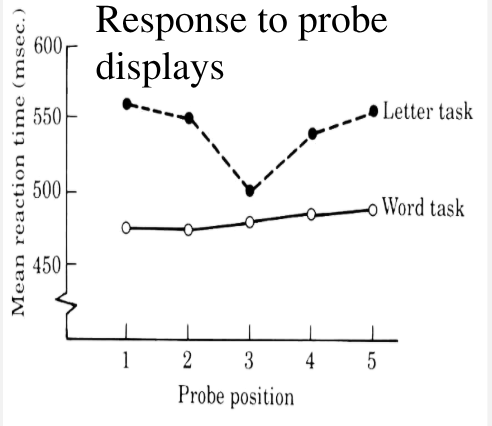
reaction time (RT) was faster for probes near the centre when attention was focused on on a single letter (letter task)
RT was faster for probes across the whole word when attention was spread out to process the entire word (word task)
this suggests flexibility in attentional focus - it can be narrowly focused or broadly distributed
visual selection and zooming the attentional spotlight
visual attention is not all-or-none: it operates on a gradient, enhancing relevant information while suppressing distractions
attention is an optional process: the size of the attended area can be voluntarily adjusted, similar to ‘zooming in’ or ‘zooming out’ with a spotlight
efficiency of early selection depends on processing load?
‘Flanker’ task: press left key for little X, right key for little Z, on midline, ignore big letter above or below mid-line (distracting flanker)
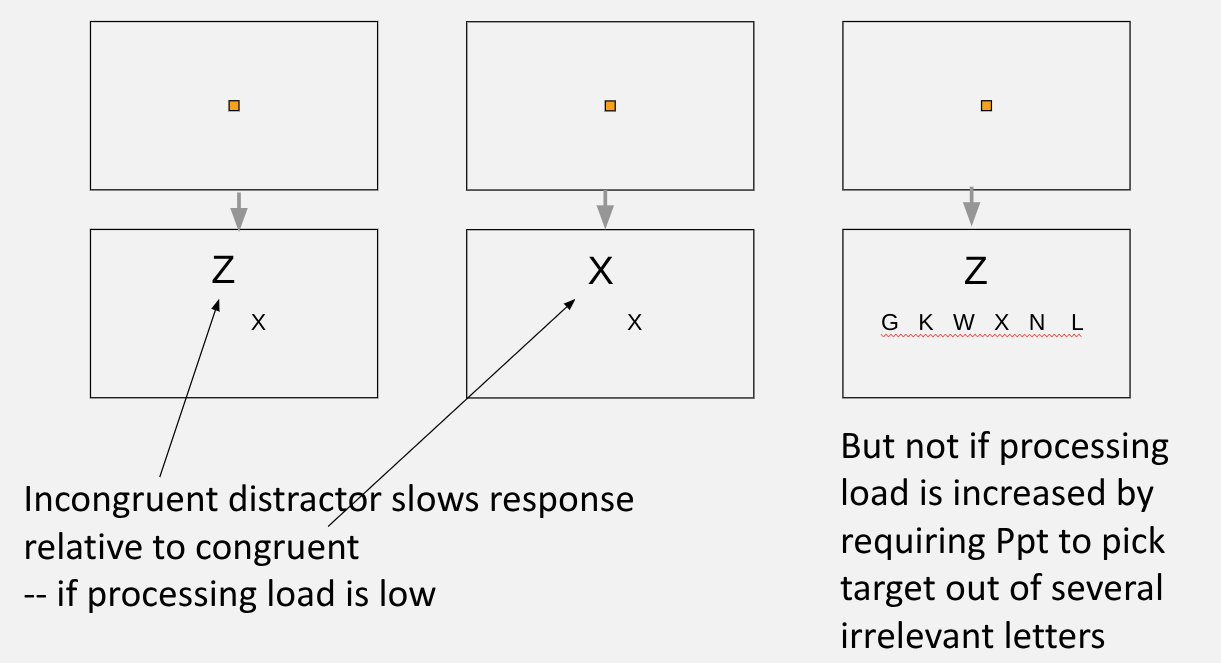
early selection is more efficient under high cognitive load
if attention is fully occupied with a demanding task, irrelevant distractors have less impact
This supports Load theory of attention: when cognitive load is high, there is less leftover attention for distractors
visual attention in dynamic scences: inattentional blindness
expts by Daniel Simon require participant to attend closely to one coherent ‘stream’ of visual events on the screen, spatially overlapping with another stream
highly salient events in the unattended stream are missed by a large proportion of participants (~50% in Simons experiments)
hence the events of the unattended stream, though happening in a part of the visual field fixated by the participant (as later eye-tracking studies show), do not appear to be processed to the level of meaning
summary of visual attention
processing of information in the visual field to the level of recognition and meaning is highly selective and limited:
the ‘spot-light’ of visual attention can be moved voluntarily (and relatively slowly) to locations/objects of potential interest away from fixation. It is attracted automatically (and relatively fast) to local transients in the visual field (eg Posner exps). The size of the spotlight can be varied or ‘zoomed’ (eg Laberge exp)
this selective filtering occurs early in the processing of visual information
processing of objects outside the ‘spotlight’ is relatively shallow (little evidence for object recognition, or activation of meaning) (eg. ‘inattentional blindness’ and visual search)
capacity and multitasking
the limiting factors
working memory capacity
speed of processing
attention
multi tasking and cognitive capacity
even when we do just one task, there are limits to cognitive capacity
all processes take tome (eg memory retrieval, decision making)
tjere are limits to the input any one process (eg syntactic parsing) can handle
representational/storage capacity is limited (eg working memory)
capacity limits become even more obvious when resources must be shared between tasks ie
have to get more than one task done in a certain time
at least some tasks are time-critical (can’t wait), so we must either
try to do them simultaneously
or switch back and forth between them
examples of real life multitasking
cooking and ironing and baby-monitoring and phone answering and door bell
chef, air traffic controller, pilot, taxi-dispatcher, driver
these limitations are important
theoretically (what is the global computational architecture of the mind/brain?)
practically (efficiency, risk - ‘human error’ as a source of accidents
multi tasking: the demands include
when we try to do the task simultaneously:
competition for shared resources - dual task interference
when we try to switch between tasks, the overhead includes:
set-shifting or task-switching costs
retrospective memory
prospective memory
monitoring for trigger conditions (is it time to do X?)
remembering the meaning of the ‘trigger’: what am I supposed to do now?)
other demands on executive control:
planning, scheduling, prioritising, coordinating the two task streams
trouble-shooting, problem-solving
when things go wrong or unexpected problems arise
so (a) multitasking is not a single competence
(b) executive control processes are critical
an example: using a mobile phone while driving
use of handset while driving now illegal in UK
use of hands-free phone not illegal, but you can be prosecuted if use is concurrent with an accident
yet many people think they can drive competently while speaking on a mobile phone, especially if using a hands-free set
but they are wrong
epidemiological studies show increased accidents (relative risk similar to driving at legal limit for alcohol)
observational studies show eg. delayed braking at T-junction
experimental studies show impaired breaking, detection of potential hazards etc. especially in young drivers
study on relative risk of mobile phone use and drinking - Strayer, drews and crouch (2006)
driver in simulator: follows a pacer car in slow lane of motorway for 15 minutes, tries to maintain distance, pacer car breaks occasionally
Baseline vs Alcohol (80mg/100ml) vs Casual talk on hand-held or hands-free mobile (call initiated before and terminated after measured driving)
mobile phone users: slower reactions, more tail-end collisions, slower recovery
alcohol: more aggressive driving (closer following, harder braking)
no significant differences between effects of talking on hand-held and hands-free!
further driving simulator studies show
(just) talking on hands-free mobile phone:
reduced (by ~50%) anticipatory glances to safety critical locations (eg parked lorry obscuring a zebra crossing)
reduced (by ~50%) later recognition memory of objects in driving environment
increased probability of unsafe lane change
does talking to passengers have the same effect? crash risk data suggests not.
simulator studies show that (unlike person on phone)
passengers are sensitive to drivers load eg stop talking, wait for reply
passengers help spot hazards, turn-offs etc
measuring dual-task interference in the lab
just two tasks, designed for measurement and manipulation
typically measures performance
on tasks A and B alone
on A and B combined
does performance on each task deteriorate when the other must also be performed?
note: must measure performance on both tasks: participant may be able to trade off performance of A and B

possible sources of dual-task interference
shower and less accurate performance in dual task conditions might be attributable to
competition for use of specialised domain-specific resources
parts of body (effectors, sense organs)
brain ‘modules’: specific processes/representations
competition for use of general purpose processing capacity
central processor?
pool of general-purpose processing resource?
limited capacity of executive control mechanisms that set up and manage the flow of information through the system
and/or sub-optimal control strategies
competition for domain-specific resources eg
certain cognitive tasks interfere with each other when they rely on the same specialised resources:
auditory processing: listening to two speech streams at once impairs comprehension, as both rely on speech perception mechanisms
visuo-spatial working memory: performing a spatial tracking task makes it harder to use visual imagery for memory tasks
dual-task interference occurs when tasks require the same sensory, response or central processing mechanisms.
However, if the information rate is low enough, resources may be efficiently switched between tasks to reduce interference
competition for a general-purpose processor?
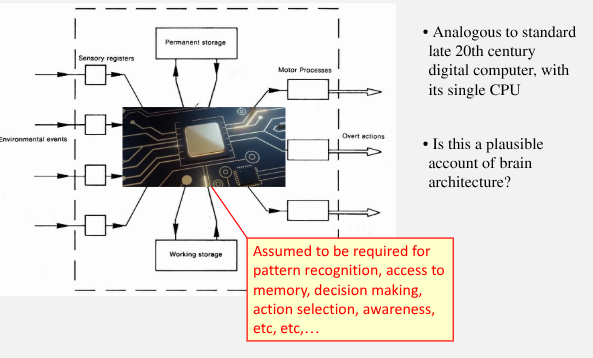
competition for a general-purpose processor?
the central processing model compares cognitive processing to a single-CPU computer:
a single processing unit is responsible for:
pattern recognition
memory access
decision-making
action selection
awareness
Posner (1978) linked this central processor to conciousness. This model suggests that ny task requiring central processing competes for the same limited resource, leading to task interference
a general-purpose resource pool?
Kahneman (1975) proposed a pool of general-purpose resources that is shared among concurrent tasks (mental energy eg attention and effort)
The capacity of the general purpose resource might vary:
over people
within people, states of alertness:
level of ‘sustained attention’ (=available ‘resource’ or ‘effort’)
diminishes with boredom or fatigue
increases with time of day (apart from post lunch dip), presence of moderate stressors (eg noise, heat, but only up to a point), emotional arousal (up to a point), conscious effort
suppose there were a central processor or resource pool, whose capacity could be shared by (any) two tasks:
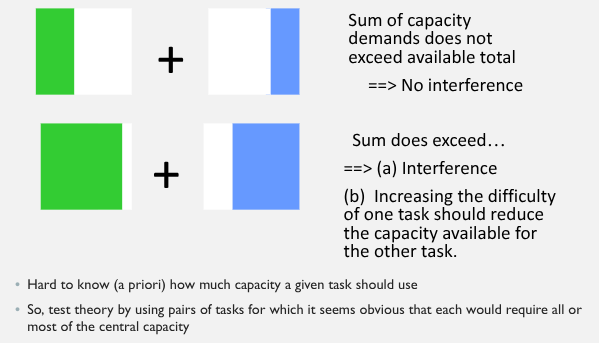
a case of demanding tasks combined without interference - allport antonis and reynolds (1972)
university of reading Y3 music studnets (competent pianists). Tasks:
A: sight-read Grade 2 (easier) or Grade 4 (harder) piano pieces.
B: shadow prose from Austen novel (easier) or text on Old Norse (harder)
relatively little practice: 10 × 1 min shadowing (to reach criterion of 2 trials with no omissions), 2 × 1 min sight-reading, 7 × 1 min dual task
experiment: two sessions of 2 × 1 min dual task for each combination of easy and hard, and 1 min sight-reading or shadowing alone (order balanced)
the rate of shadowing and number of shadowing errors were no different with and without concurrent sight reading
concurrent shadowing also did not increase sight reading errors
more shadowing error for harder text, and more sight-reading errors for grade 4 pieces (difficulty manipulations effective), but (by session 2):
shadowing performance not influenced by difficulty of music piece
sight-reading performance not influenced by difficulty of prose shadowed
dual-task interference challenge
write down numbers 1 to 10
now, say the alphabet from A to T
now, alternate between writing a number and saying a letter (eg write ‘I’, say ‘A’, write ‘2’, say ‘B’ etc)
how multitasking slows performance due to switching costs and dual-task interference
two more examples
evidence against a general-purpose processing bottleneck
tasks can be combined without interference:
Shaffer (1975): skilled typists can visually copy-type while shadowing prose (repeating spoken words aloud) without interference
suggests parallel processing of distinct tasks when they rely on separate cognitive resources
task difficulty doesn’t always influence performance:
North (1977): a continuous tracking task was combined with a digit recognition task (identifying/classifying number)
increasing difficulty of the digit task did not slow performance in the tracking task
this suggests that when tasks rely on different cognitive systems, they can operate independently
the radical claim: no central general-purpose processor/resource - Allport, 1980
Allport (1980) rejected the idea of a single ‘central processor’. Instead, tasks rely on seperate, non-overlapping modules (eg. sensory modalities, motor control, memory systems)
If tasks engage different brain networks, they can be performed simultaneously with little interference
this challenges Kahneman’s (1975) general-resource theory, which posited a shared attentional pool.
but, even when task use completely different modules, some interference may arise due to coordination and control demands - ie as a consequence of the load on (specialised) cognitive processes
eg Allport et al error in one task briefly slows the other
back to driving and phone conversation
si it isn’t the case that
a - driving/navigation (visuo/spatial input →hand/foot responses) and
b - conversation (speech input ←—→ meaning ←—→ speech production)
require use of quite different ‘modules’?
yes and no. they use different input and output modalities, but both require construction of a ‘mental model’
(for driving: representation of route, goals, progress, meaning of road-signs, interpretation of observed events, prediction of potential hazards etc)
the construction of the mental model for driving can be interfered with by a conversation that asks the driver to think about a visuo-spatial arrangement (eg when we get to X, do you know how to find Y) or imagine movements
the importance of practice
tasks which cannot be combined without interference become easier to combine with practice.
Eg. changing gear while driving
Spelke Hirst and Neisser (1976): after 85 hours of practice at:
reading stories (for comprehension) at the same time as writing to dictation (6 weeks)
( and then)
reading stories concurrent with writing category of spoken words (11 weeks)
some participants showed little dual-task interference
because?
practising one task automates it: reduces need for ‘executive’ control of the constituent processes
practising combining tasks develops optimal control strategies for combining that particular task pair
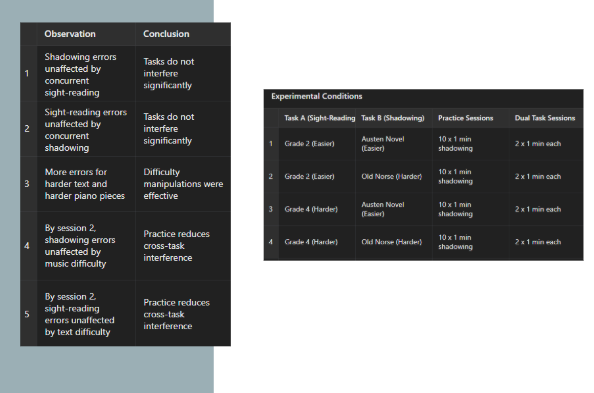
Broadbent’s objection to Allport-type experiments - Broadbent (1982)
with pairs of continous tasks like shadowing and sight-reading there is
some predictability in the input (ie can anticipate)
a substantial lag between input and output (so there must be temporary storage in WM of input and/or output)
so, there could still be a central processor switching between the two tasks (time-sharing). While processor services one task, input/output for the other task could be stored in WM buffers
test: processor-switching should be revealed if we use concurrent tasks with very small lags between input and output, and the next stimulus unpredictable ie reaction time tasks
the ‘psychological refractory period (PRP)’ - Welford, 1952
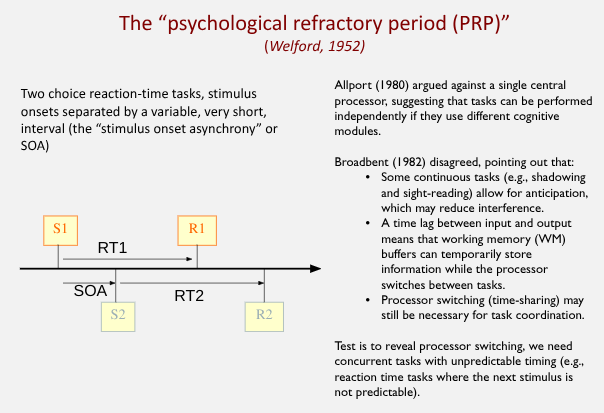
PRP demonstrates a fundamental limit in multitasking, supporting the idea of a central bottleneck.
Two choice reaction-time tasks occur in quick succession.
Stimulus I (SI) → response I (RI)
after a short delay (Stimulus Onset Ansynchrony, SOA), stimulus 2 (S2) → response 2 (R2)
When SOA is short:
RTI remains stable
RT2 is delayed (bottleneck effect)
As SOA increases, RT2 speeds up because the bottleneck is cleared
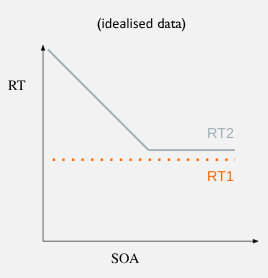
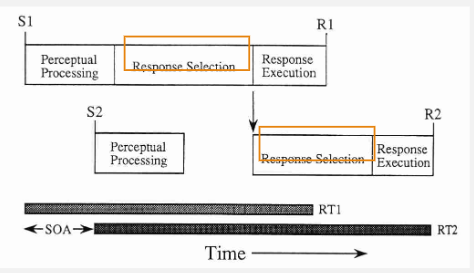
Response selection is the processing bottleneck:
only one response selection process can occur at a time
if a second stimulus is identified while the first response is being selected, it must wait until the first response is completed
This explains why RT2 is delayed at short SOAs
conclusions
real multi-tasking is rare to achieve; it is better (and often more efficient) to focus on one task at a time
why? switching attention constantly consumes energy and drains cognitive resources
executive control is needed to do the coordinating, scheduling, prioritising and these mechanisms have capacity limits, being constantly on alert leads to fatigue, burn outs etc